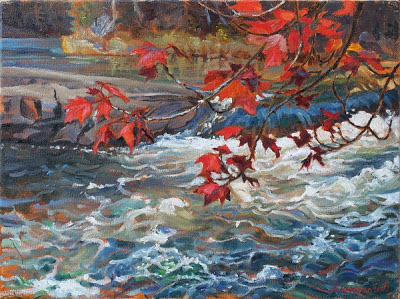Wanatango Falls Bioinventory (oil on canvas 5 x 7 in.) Sold
On 19 September, as I sat finishing my painting on the bank of the Frederickhouse River, Fred noticed the moss along the sides of the Wanatango Falls, especially a bright green species that made a conspicuous patch on the west side, and he set out across the angular rocks to gather a sample of the species represented. He tried to point out to Marigold the Dog that the rocks and water were too irregular for her convenience, but she followed
him anyway, though many of the rocks proved much harder for a narrow-footed dog to traverse than they were for a cog-shod naturalist. After packing up my paints I stood, and photographed them traversing the rocks.
Fred found a dull widespread species here, but the bright green kind that forms 30 cm patches on the west side of the spillway is only small and tucked into cracks where he could reach it on this side. He also collected the dark and lichen-topped species that made little dark patches higher up on the rocks. You'll see that he's collecting into one of the 8000 7-litre popcorn bags of which we still have a couple of boxes - inherited from a failed snack concession in Ottawa in 1983.
Marigold's interest was captured by relatively fresh Crayfish carcasses on the rocks, which she munched up, leaving only the older, bleached-white ones for Fred, but enough intact rostra for him to see that both Orconectes propinquus and O. virilis were represented. There were hundreds of chelipeds not picked up. From the drought in southern Ontario, we've come north expecting at least fairly low water levels, but find all the rivers and many of the lakes fairly high, which means that our sampling of shells along the shore only finds the common species of mussels.
The banks of these U-shaped Claybelt rivers are nearly vertical, and the water is turbid with clay, so it's only in years when the water level is low that one can find the shells and living clams of the more uncommon species. Downstream of the falls, near an inactive shore-bound Beaver lodge on the steep clay, some of the Mucket shells were 3 metres above the current water level, leading us to wonder how they get so high. Were they carried there by Beavers or washed up by floods? These steep shores are lined with Alnus (Alder), Salix (Willow), Cornus stolonifera (Red-osier Dogwood), and grasses, and there was enough of a scattering of Lampsilis radiata siliquodea Fat Muckets, and a few Pyganodon Floaters, to keep Fred looking, hoping, for another species.
Marigold enjoyed muddying the water by dashing back and forth along the shore. Right at the edge, the Water Horsetail (Equisetum fluviatile) graded from a long-armed form on land to nearly branchless stems in the water, a very striking difference in a matter of only 25 cm of the steep shore.
Fred has now dried and packed the specimens and entered their locations into the database. When we get home he'll go through and identify them and get them ready for deposit in museums.
him anyway, though many of the rocks proved much harder for a narrow-footed dog to traverse than they were for a cog-shod naturalist. After packing up my paints I stood, and photographed them traversing the rocks.
Fred found a dull widespread species here, but the bright green kind that forms 30 cm patches on the west side of the spillway is only small and tucked into cracks where he could reach it on this side. He also collected the dark and lichen-topped species that made little dark patches higher up on the rocks. You'll see that he's collecting into one of the 8000 7-litre popcorn bags of which we still have a couple of boxes - inherited from a failed snack concession in Ottawa in 1983.
Marigold's interest was captured by relatively fresh Crayfish carcasses on the rocks, which she munched up, leaving only the older, bleached-white ones for Fred, but enough intact rostra for him to see that both Orconectes propinquus and O. virilis were represented. There were hundreds of chelipeds not picked up. From the drought in southern Ontario, we've come north expecting at least fairly low water levels, but find all the rivers and many of the lakes fairly high, which means that our sampling of shells along the shore only finds the common species of mussels.
The banks of these U-shaped Claybelt rivers are nearly vertical, and the water is turbid with clay, so it's only in years when the water level is low that one can find the shells and living clams of the more uncommon species. Downstream of the falls, near an inactive shore-bound Beaver lodge on the steep clay, some of the Mucket shells were 3 metres above the current water level, leading us to wonder how they get so high. Were they carried there by Beavers or washed up by floods? These steep shores are lined with Alnus (Alder), Salix (Willow), Cornus stolonifera (Red-osier Dogwood), and grasses, and there was enough of a scattering of Lampsilis radiata siliquodea Fat Muckets, and a few Pyganodon Floaters, to keep Fred looking, hoping, for another species.
Marigold enjoyed muddying the water by dashing back and forth along the shore. Right at the edge, the Water Horsetail (Equisetum fluviatile) graded from a long-armed form on land to nearly branchless stems in the water, a very striking difference in a matter of only 25 cm of the steep shore.
Fred has now dried and packed the specimens and entered their locations into the database. When we get home he'll go through and identify them and get them ready for deposit in museums.




This is beautiful, Aleta.
ReplyDeleteK